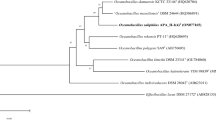Abstract
Six strains of moderately thermophilic sulfur-oxidizing bacteria were isolated from several different typical environments in China. The identities of the isolates were confirmed by analyses of their 16S rRNA genes, and some key physiological traits. The isolates are Gram negative, rod-shaped bacteria, their optimal temperature and pH value for growth are 45–50 °C and 2.5–3.5 respectively. They are autotrophic and used elemental sulfur, sodium thiosulfate and potassium tetrathionate as electron donor, while a little glucose stimulated their growth. 16S rDNA sequences analysis reveals that the strains are phylogenetically clustered to Acidithiobacillus caldus.
Similar content being viewed by others
References
DENG **g-shi. Bioleaching of Nickel Containing Pyrite by Moderately Thermophilic Bacteria[D]. Kunming: Kunming University of Science and Technology, 2002. (in Chinese)
RAWLINGS D E. Characteristics and adaptability of iron-and sulfur-oxidizing microorganisms used for the recovery of metals from minerals and their concentrates[J]. Microbial Cell Factories, 2005, 5(4): 13–18.
OLSON G J, BRIERLEY J A, BRIERLEY C L. Bioleaching review B: Processing in bioleaching: applications of microbial processes by the minerals industries[J]. Appl Microbiol Biotechnol, 2003, 63(3): 249–257.
ROHWERDER T, GEHRKE T, KINZLER K, et al. Bioleaching review A: Progress in bioleaching fundamentals and mechanisms of bacterial sulfide oxidation[J]. Appl Microbiol Biotechnol, 2003, 63(3): 239–248.
ZHOU Hong-bo, LIU **, QIU Guan-zhou, LIU Jian-she, et al. Immobilization of Acidithiobacillus ferrooxidans and ferric iron production[J]. Trans Nonferrous Met Soc China, 2006, 16(4): 931–936.
KELLY D P, WOOD A P. Reclassification of some species of Thiobacillus to the newly designated genera Acidithiobacillus gen. nov., Halothiobacillus gen. nov. and Thermithiobacillus gen. nov.[J]. Syst Evol Microbiol, 2000, 50(2): 511–516.
NAOKO O, MARIEKIE G, HALLBERG B, et al. Enumeration and characterization of acidophilic microorganisms isolated from a pilot plant stirred-tank bioleaching operation[J]. Appl Environ Microbiol, 2003, 69(4): 1936–1943.
FOUCHERA S, BRUNETA F B, D’HUGUESA P, et al. Evolution of the bacterial population during the batch bioleaching of a cobaltiferous pyrite in a suspended solids bubble column and comparison with a mechanically agitated reactor[J]. Hydrometallurgy, 2003, 71(1): 5–12.
DOPSON M, LINDSTROM E B. Analysis of community composition during moderately thermophilic bioleaching of pyrite, arsenical pyrite, and chalcopyrite[J]. Microbial Ecology, 2004, 48(1): 19–28.
RAWLINGS D E, CORAM N J, GARDNER M N, et al. Thiobacillus caldus and Leptospirillium ferrooxians are widely distributed in continuous-flow biooxidation tanks used to treat a variety of metal-containing ores and concentrates [C]// AMILS R, BALLESTER A. Biohydrometrallurgy and the Environment Toward the Mining of the 21st Century. Part A. Amsterdam: Elsevier Press, 1999: 773–778.
ROBERTSON W J, KINNUNEN P H M, PLUMB P D, et al. Moderately thermophilic ferrous-iron oxidizing bacteria isolated from a pyretic coal deposit showing spontaneous combustion [J]. Minerals Engineering, 2002, 15(11): 815–822.
QIU Guan-zhou, FU Bo, ZHOU Hong-bo, et al. Isolation of a strain of Acidithiobacillus caldus and it’s role in bioleaching of chalcopyrite[J]. World J Microbiol Biotechnol, 2007, In Press.
DOPSON M, BÖRJE L E. Potential role of Thiobacillus caldus in arsenopyrite bioleaching[J]. Appl Environ Microbiol, 1999, 65(1): 36–40.
MARCHESI J R, SATO T, WEIGHTMAN A J, et al. Design and evaluation of useful bacterium-specific PCR primers that amplify genes coding for bacterial 16S rRNA[J]. Appl Environ Microbiol, 1998, 64(2): 795–799.
RAWLINGS D E. Heavy metal mining using microbes[J]. Annual Review of Microbiology, 2002, 56: 65–91.
General test method in salt industry-determination of sulfate ion, China. GB/T 13025.8-91. https://doi.org/www.foodmate.net/standard/sort/3/4882.html
SEMENZA M, VIERA M, CURUTCHET G, et al. The role of Acidithiobacillus caldus in the bioleaching of metal sulfides[J]. Latin Am Appl Research, 2002, 32(4): 303–306
Author information
Authors and Affiliations
Corresponding author
Additional information
Foundation item: Project (50321402) supported by the National Natural Science Foundation of China; Project(2004CB619204) supported by the State Basic Research Development Program of China; Project (DY105-02-04-05) supported by the China Ocean Mineral Resources Research and Development Association
Rights and permissions
About this article
Cite this article
Zhou, Hb., Liu, X., Fu, B. et al. Isolation and characterization of Acidithiobacillus caldus from several typical environments in China. J Cent. South Univ. Technol. 14, 163–169 (2007). https://doi.org/10.1007/s11771-007-0033-0
Received:
Accepted:
Published:
Issue Date:
DOI: https://doi.org/10.1007/s11771-007-0033-0




